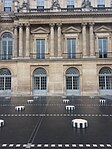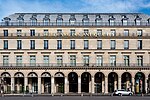Conseil d'État (France)

In France, the Council of State (French: Conseil d'État, [kɔ̃sɛj deta]) is a governmental body that acts both as legal adviser of the executive branch and as the supreme court for administrative justice. Established in 1799 by Napoleon as a successor to the King's Council (Conseil du Roi), it is located in the Palais-Royal in Paris and is primarily made up of top-level legal officers. The Vice President of the Council of State ranks as the ninth most important civil servant in France. Members of the Council of State are part of a Grand Corps of the French State (Grand corps de l'État). The Council of State mainly recruits from among the top-ranking students graduating from the École nationale d'administration.
Excerpt from the Wikipedia article Conseil d'État (France) (License: CC BY-SA 3.0, Authors, Images).Conseil d'État (France)
Place de Valois, Paris 1st Arrondissement (Paris)
Geographical coordinates (GPS) Address Nearby Places Show on map
Geographical coordinates (GPS)
| Latitude | Longitude |
|---|---|
| N 48.863333333333 ° | E 2.3369444444444 ° |
Address
Palais Royal
Place de Valois
75001 Paris, 1st Arrondissement (Paris)
Ile-de-France, France
Open on Google Maps











